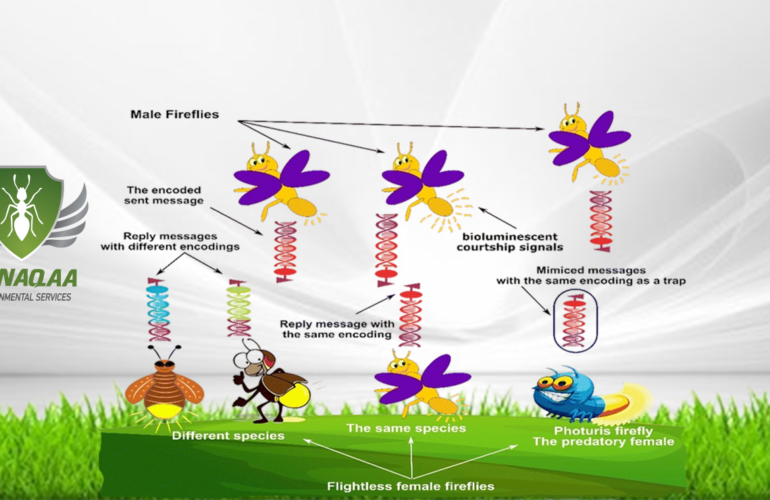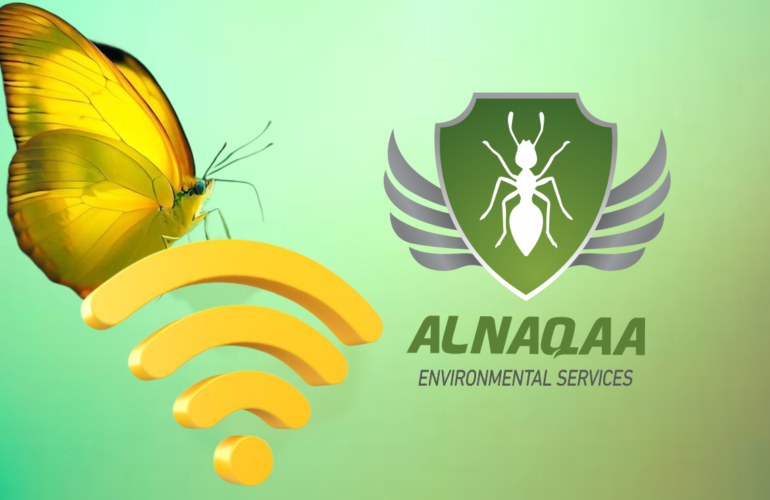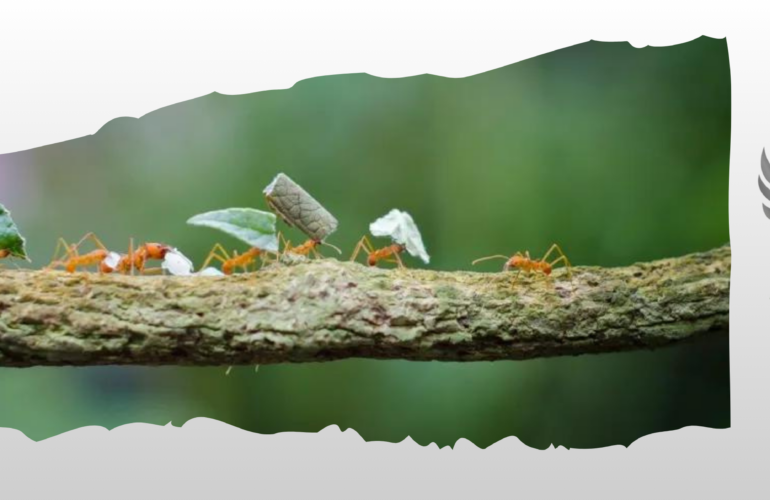Mysterious Facts about Insects
Alnaqaa for environmental services- Ras Alkhaima-United Arab Emirates is now seeking to unleash many facts about insects, not only their control, when encountering them as pests but also highlighting the other fascinating side of their world!
The insect world is always fascinating with its behavior, colors, shapes, and products as well as the various habitats they are adapted to live in. Entomologists are scientists who are interested in studying the world of insects. So, they are primarily specialists in understanding this mysterious fact about the insect world.
Let’s start with the general mysterious facts about the insect world.
-Insect Migration: Some insect species undertake incredible long-distance migrations, covering thousands of kilometers. For example, the monarch butterfly migrates from Canada to Mexico, a journey that takes several generations to complete. How they navigate and find their way back to their original location remains a mystery.
-Insect Communication: Insects communicate using a variety of methods, including pheromones, sounds, and vibrations. Some species of ants, for instance, use chemical trails to guide other members of their colony to food sources. The exact mechanisms and intricacies of insect communication are still being researched.
-Hive-Mind Behavior: Social insects, like bees and ants, exhibit complex hive-mind behavior. They work together in a coordinated and efficient manner to achieve common goals, such as building intricate nests or locating food. The mechanisms behind how these insects communicate and coordinate their actions within the colony are still not fully understood.
-Insect Mimicry: Many insects have evolved remarkable mimicry strategies to deceive predators or prey. For instance, certain species of praying mantises resemble flowers or leaves, allowing them to blend seamlessly with their surroundings. The precise mechanisms by which insects develop and maintain such mimicry adaptations are still being studied.
-Insect Intelligence: While insects have relatively small brains, they exhibit surprising levels of intelligence and problem-solving abilities. Bees, for example, can perform complex tasks like recognizing and remembering specific floral patterns and communicating that information to other bees. The cognitive processes and capabilities of insects continue to be a subject of scientific inquiry.
-Insect Bioluminescence: Some insects possess the ability to produce light through bioluminescence. Fireflies are a well-known example, where males use their flashing light patterns to attract mates. The exact biochemical processes that enable insects to emit light are not fully understood and continue to be a subject of research.
-Insect Camouflage: Many insects have developed remarkable camouflage abilities to blend in with their surroundings and avoid detection by predators. For instance, certain stick insects resemble twigs or branches, making them virtually indistinguishable from their environment. The mechanisms by which insects achieve such effective camouflage are still being explored.
-Insect Reproduction: Insects exhibit a wide range of reproductive strategies, including complex mating rituals, sexual dimorphism, and unique reproductive organs. Some insects, like the honeybee queen, can store sperm for several years and selectively control the fertilization of eggs. The intricacies of insect reproductive behaviors and mechanisms continue to be a fascinating area of study.
Abnormal and extraordinary insect behavior can be fascinating and often serve as a means of survival or adaptation. Here are a few examples:
1. Zombie Insects: Some insects, like certain species of ants and wasps, can become hosts to parasitic organisms that manipulate their behavior. For instance, the parasitic fungus Ophiocordyceps infects ants, taking control of their nervous system and compelling them to climb to elevated positions before ultimately killing them, which helps the fungus spread its spores.
2. Swarm Intelligence: Insects such as bees and ants exhibit swarm intelligence, where a large group of individuals collectively makes decisions and carries out complex tasks. This behavior allows them to accomplish feats like building elaborate nests, foraging efficiently, and defending themselves from threats.
3. Luminous Courtship Displays: Many insects, such as fireflies and glowworms, exhibit bioluminescent courtship displays. Males produce light patterns or flashes to attract females for mating. These mesmerizing displays are species-specific and often involve precise timing and synchronization.
4. Protective Mimicry: Some insects have evolved to mimic the appearance or behavior of other organisms for protection. For example, the walking stick insect resembles a twig or branch, camouflaging itself from predators. Similarly, certain butterfly caterpillars mimic bird droppings to deter predators.
5. Extreme Metamorphosis: Insects like butterflies and moths undergo complete metamorphosis, transforming from larvae (caterpillars) to adult forms (butterflies/moths). This remarkable process involves dramatic changes in body structure, behavior, and even diet, allowing them to exploit different ecological niches at different life stages.
These examples demonstrate the incredible adaptability and diverse strategies that insects have developed to survive and thrive in their respective environments. They continue to inspire scientific research and deepen our understanding of the natural world.
These mysterious aspects of insect behavior and biology highlight the remarkable diversity and complexity of the insect world, and ongoing research continues to shed light on these intriguing phenomena.
How do scientists study the cognitive processes and problem-solving abilities of insects?
Studying the cognitive processes and problem-solving abilities of insects is a fascinating field of research. Scientists employ various methods and experimental setups to gain insights into the cognitive capabilities of these small creatures. Here are a few common approaches:
1. Behavioral Experiments: Scientists design experiments to observe and analyze the behavior of insects in response to specific stimuli or tasks. For example, honeybees may be trained to navigate mazes or make choices based on visual cues. By carefully designing and analyzing these experiments, researchers can infer the cognitive processes underlying the insects’ behavior.
2. Learning and Memory Tests: Researchers use conditioning and learning tests to investigate an insect’s ability to learn and remember information. Insects may be trained to associate specific cues with rewards or punishments and then tested to see if they can recall and respond to those cues correctly. These tests provide insights into an insect’s memory retention and retrieval abilities.
3. Problem-Solving Tasks: Scientists create problem-solving tasks that require insects to demonstrate ingenuity in finding solutions. For example, an insect might be faced with a barrier blocking its path to food, and researchers observe how the insect navigates or overcomes the obstacle. These tasks assess an insect’s ability to adapt, plan, and use problem-solving strategies.
4. Neurobiological Studies: Researchers also investigate the neural mechanisms underlying insect cognition. They study the structure and function of the insect brain, identify specific regions associated with cognitive processes, and analyze neural activity during behavioral tasks. Techniques such as electrophysiology and neuroimaging help researchers understand the neural correlates of cognition in insects.
5. Comparative Studies: Scientists compare the cognitive abilities of different insect species to identify commonalities and differences. By examining a broad range of insects with varying ecological and behavioral traits, researchers can gain insights into the evolution of cognitive processes in insects and how they relate to specific ecological niches.
6. Mathematical Modeling: Mathematical models are used to simulate and predict insect behavior based on certain cognitive assumptions. These models help researchers understand how insects make decisions, learn, and solve problems. By comparing model predictions with observed behavior, scientists can refine their understanding of insect cognition.
It’s important to note that studying insect cognition is a rapidly evolving field, and new techniques and approaches continue to emerge. The combination of behavioral experiments, neurobiological studies, comparative analyses, and computational modeling allows scientists to explore and unravel the mysteries of insect cognitive processes and problem-solving abilities.
At last, Alnaqaa for Environmental Services- Ras Al Khaimah-United Arab Emirates hopes you liked this new insight towards intermingling practice and culture in the insect world with the help of our scientific consultants who are devoted to helping readers understand this fascinating world of insects!






